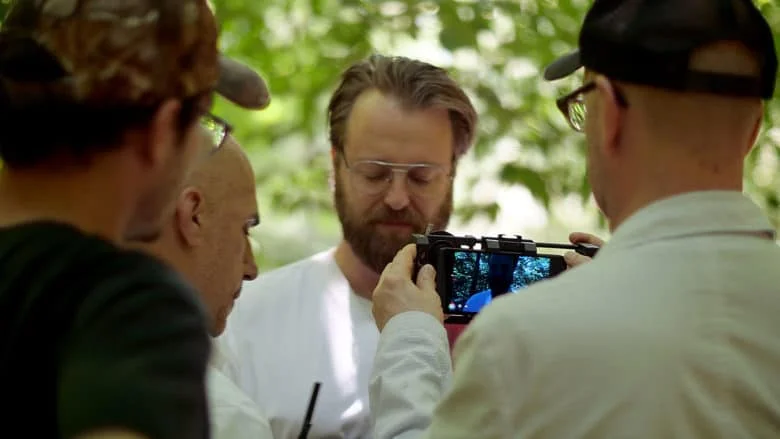Interview: 'Unsane' actor Joshua Leonard
Since making one of cinema's more memorable debuts with 1997's The Blair Witch Project, Joshua Leonard has remained an active member of the independent film community. His resumé includes collaborations with Lynn Shelton (Humpday), Jay and Mark Duplass (HBO's Togetherness) and now counts indie icon Steven Soderbergh.
In the newly-unretired director's thriller Unsane, Leonard plays David Strine, former stalker of the film's protagonist Sawyer Valentini (Claire Foy), whose face she improbably sees on a male nurse in the mental institution to which she's unwittingly been admitted. A filmmaker himself, whose second narrative feature Behold My Heart opens this summer, Leonard recently spoke with me about making Unsane and the numerous benefits of acting in the midst of a certain piece of ubiquitous technology.
Edwin Arnaudin: One of the many intriguing aspects of Unsane is that it kind of came out of nowhere. There was word Steven Soderbergh was out of retirement, had made Logan Lucky and, oh, by the way, he has a thriller coming out soon, too. So, I’m curious about the secrecy of Unsane’s production. What rules did you have to abide by upon joining the cast?
Joshua Leonard: I was not allowed to say anything to anybody ever. [Laughs] In fact, to the extent that when I originally got the call asking if I had any interest in being involved with the movie, in playing the Strine role, Carmen Cuba, who’s a friend of mine and Steven’s longtime casting director, called and said…you know, she was so cagey when she pitched it. [Laughs] She said, “I’ve got this thriller. We’re going to make it independently. It’s a really interesting filmmaker, but we’re doing it small and it’s being shot on an iPhone and the filmmaker is interested in you for the lead bad guy role.”
And I love playing bad guys. Bad guys are fun to play and I’d never played anybody like this, but I also had an 8-month-old daughter at the time and doing a little indie film in New York was not really in the cards because [my wife — actress Alison Pill — and I] live in Los Angeles. And I said, “Carmen, thank you so much for thinking of me, but it’s just…any other time, I would love to, but now is not a good time with a brand new kid, going to do something for no money, shot on an iPhone.” And she’s like, “I really think you should just talk to the director.” And I said, “You know, I don’t want to because I don’t want to get convinced to do it because my wife’s going to shoot me in the face if I tell her I’m going to make $3 and am leaving town for a month.” And she was like, “OK. Fine, fucker: It’s Steven Soderbergh. How do you feel now?” And I was like, “I will take that shot in the face from my wife and, you know, my baby’ll never remember it happened. She’s not even a year old. What the fuck is she going to remember?” [Laughs]
So, even in the initial pitch it was something that was super top-secret. And then I couldn’t tell anybody what I was going to do. It was on a pretty tight lockdown, which…I think now, having worked with Steven and getting to know him a little bit, I understand. And I understand the validity of his concern, which is really…and I think he’s said as much publicly, which is, “I didn’t retire because I don’t love filmmaking. I retired because I got sick of dealing with the bullshit of the business.” So, I think really, right now, his focus is on…"With a little bit of time off and a little bit of hindsight, how can I go back to making movies more about making movies?” or “How can I go back to the process of making movies being more about the creation of this thing as opposed to the business of entertainment?” And I think it’s a lot easier to do when you don’t have a bunch of people with predispositions forming opinions before they even know what you’re doing about what you’re doing.
EA: And then the other big news about the film is that it was shot on an iPhone — but it’s such a good-looking film that I quickly stopped thinking about how it was made. I’m curious, as an actor, did you have a similar experience when it came to performing around this unusual equipment?
JL: I think you also drew attention to something that I do want to talk about a little bit, which is just the fact that…we’re getting all this press around the fact that that this movie was shot on an iPhone because I think it’s still a bit of a novelty. Other than Sean Baker’s film [Tangerine], I don’t think there’s another film that’s been talked about much that was shot on an iPhone. Steven was very explicit about the aesthetic of the movie, and the fact that it was shot on an iPhone is not a conceit of the film itself. Whereas 20 years ago when we were making Blair Witch, the fact that the film was going to look shitty and not sound great was part of the conceit of this film that was made by three student filmmakers who had this amateur digital equipment. And I think because of where the technology has come in those last 20 years, Steve no longer has to be…and probably if this film was made five years from now, it wouldn’t even be part of the conversation. So, I hope people know that. When you sit in the theater, it looks and feels like a film. It’s not a gimmick.
For us as actors, it was just… I think because we’re all so used to the iPhone in our lives as technology that’s really omnipresent and doesn’t feel threatening that it gave us a tremendous amount of freedom as actors and reduced some of the self-consciousness that can sometimes go into shooting a scene where it’s impossible not to be conscious of the big camera with the big lens in the room. And the iPhone just kind of fades into background. It made it much more about being able to play with our scene partners. We were never waiting around for the camera to get set up. We were never waiting around for lighting, no matter where Steven wanted to put the camera, and I think he puts the camera in interesting places, which is part of what makes him such a great filmmaker.
EA: Absolutely.
JL: It was really a fast-moving train, which is exciting as a collaborator because it just reduces the length of time between creative impulse and execution. So you’re just moving. You’re always moving and making things. And part of what can be frustrating about filmmaking is sometimes it is a really time-consuming, super cumbersome process, and you find yourself trying to psych yourself up and get excited and get back into character for a scene that you shot the first half of six hours previous, or two months previous. [Laughs]
Leonard in The Blair Witch Project (Photo: Lions Gate Films)
EA: Looking over your filmography, there’s Blair Witch and lots of solid indie films like Humpday and Higher Ground, plus the excellent Togetherness and now Unsane. It seems like whenever something new and exciting is happening in independent cinema or TV, there you are.
JL: [Laughs]
EA: Is that coincidence and good timing or do you feel like you’ve built a reputation as someone willing to try new things?
JL: I don’t know if it’s so much a reputation. Maybe it’s the fact that even into my early 40s, people know I will still work for $3.
EA: [Laughs]
JL: [Laughs] But, no, what I would attribute it to more than anything is…just going back to what we were talking about before of my love for filmmaking being the filmmaking itself and not necessarily all the baggage that can sometimes come along with it. As a creative person and as, you know, in my personal life, I like to do something and then move on. I like to be a little bit off balance. I’m not necessarily patient — I like making stuff. And so I think part of that is I’ve just gravitated over the last 20 years towards people with similar temperaments and impulses — the Duplass guys being a perfect example of guys who never rest on their laurels. Steven Soderbergh being a perfect example of somebody who never stops experimenting with the craft, whether it be shooting it in a new genre or technique or the jobs that he takes on on-set. It’s way more fun to make a film than to wait and make a film.
(Photos: Bleecker Street)







